Slamming the Anthropocene: Performing climate change in museums
The Anthropocene
Today’s museums are generally expected to use their objects and collections in ways that extend beyond exhibitions. Theatrical events, for example, can provide important complementary activities. This particularly applies to public issues such as climate change and nature conservation, which are often framed in scientific and technical terms. An exhibition is expensive to mount and demands long lead times, but a public program is ‘light on its feet’; it can respond to a topical moment such as a sudden disaster, and it can incorporate new scientific findings where relevant.
One way to make such debates inclusive and non-technical is to explore through performance the cultural and emotional dimensions of living with environmental change. Violent Ends: The Arts of Environmental Anxiety, staged at the National Museum of Australia in 2011,is an example of a one-day event that used art, film and performance to explore anxieties and public concerns about climate change. The event opened with the Chorus of Women, who sang a ‘Lament for Gaia’, and it concluded with ‘Reconciliation’, both works excerpted from The Gifts of the Furies (composed by Glenda Cloughly, 2009).[1] The performance presented issues that are often rendered as ‘dry science’ in a way that enabled emotional responses to be included in discussions about global warming. A legacy of this event is a ‘web exhibition’ that includes podcasts, recordings and some of the art, including that of a leading Australian environmental artist, Mandy Martin, whose more recent work we discuss further below.[2] The curators of the event, Carolyn Strange (Australian National University), Libby Robin (National Museum of Australia and Australian National University), William L Fox (Director of the Center for Art+Environment, Nevada Museum of Art, Reno) and Tom Griffiths (Director of the Centre for Environmental History, Australian National University), are all scholars with active partnerships in the arts and the museum sector. Violent Ends explored climate change through a variety of environmental arts. Since 2011, we have seen many comparable programs, in Australia and beyond.
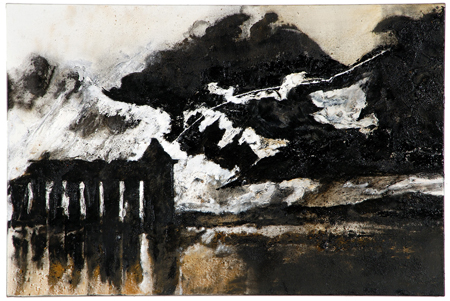
©Mandy Martin
In this paper, we review some recent international museum and events-based ideas emerging around the concept of the Anthropocene, the proposition that the Earth has now left the Holocene and entered a new epoch: The Anthropocene (or Age of Humans). The Anthropocene is defined by changes in natural systems that have occurred because of the activities of humans. It is an idea that emerges from earth sciences, but it is also cultural: indeed the geological epoch of the Holocene (the last 11,700 years) marks the period in which most of the world’s major civilisations and cultures have emerged; it includes both the Agricultural and Industrial revolutions. To assert that the planet has moved ‘beyond the Holocene’ is to assert that humanity (indeed all life) has entered a new cultural and physical space that has not been previously experienced. Questions of how humans live in a planet with changed atmosphere, oceans, land systems, cities and climates are moral as well as physical. Archbishop Desmond Tutu has described climate change as the greatest human rights issue of our times.[3]
The Anthropocene epoch is defined by material evidence of human activities that have affected the way biophysical systems work. The stratigraphers (geologists) who decide if the new epoch should be formalised are seeking evidence of human activities in the crust of the earth, in rock strata, as this is the way boundaries between geological eras, epochs and ages have been traditionally defined.[4] Paul Crutzen, a Nobel-Prize-winning atmospheric chemist and the author of the original proposal to name the new epoch the ‘Anthropocene’, has focused on global systems, particularly evidence such as CO2 levels in the atmosphere (showing the burning of fossil fuels) and pH factors in the oceans (showing acidification caused by agricultural outfalls).[5]
Perhaps the most important question is not whether the Holocene has ended but, if it has, how are people (and the cultural systems that have evolved in the Holocene years) to live with such change? The idea of an uncharted new Age of Humans has attracted considerable attention from creative artists, museum curators and scholars in the environmental humanities.[6] Even as the stratigraphers debate the end of the Holocene, global change is upon us, and the creative sector has tackled these questions in its own way. One art and ethnographic museum, the Haus der Kulturen der Welt (HKW), Berlin, hosted the most recent scientific meeting of the International Commission on Stratigraphy in October 2014.[7] HKW, with its mission to represent ‘all the cultures of the world’, recognises that the ‘people’ focus of the Anthropocene demands debate that is both cultural and scientific, and that is concerned with more than just the people of the West. The HKW Anthropocene Project and Anthropocene Curriculum have a strong artistic and museum sector focus, which we discuss further below.[8]
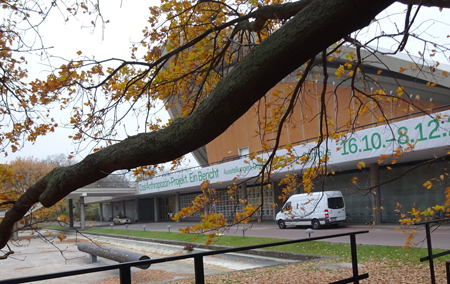
photograph by Libby Robin
Environmental humanities scholars of the Anthropocene emphasise the questions of justice (and injustice) embedded in planetary changes. Changes to climate, air quality and oceans, and loss of biodiversity are caused by subsets of humans (not all humanity) and their effects are felt by different people, and of course ultimately all life on Earth. The challenge for the humanities is to enable the voices of the people who suffer from the changes, or advocate on behalf of other creatures, to be part of the conversations that contribute to adapting cultural practices in response. People are already living with rapid change: the so-called ‘Great Acceleration’ of changes since the 1950s includes sharp growths in population, wealth and global financial systems, as well as biodiversity loss, ocean acidification, atmospheric carbon dioxide and inequalities between rich and poor.[9] All these changes together are unsettling, yet people are seeking positive, resilient futures in the face of ‘strange change’. This is a debate where the creative sector – design, architecture, museums and humanistic scholarship – is well-poised to make contributions to ideas for living in a changed world of the future. Artists and scientists alike want a broad-based future, not just one that simply ‘reduces the future to climate’, in the apt phrase of Mike Hulme, one of the world’s leading climate scientists.[10]
The Anthropocene is defined by its materiality. The fossil systems that trace its onset and evolution may be buried under layers of rock, lava or sea, as were the traces of earlier epochs. Stratigraphers seeking ‘markers’ for this epoch look for material that might survive the end of an age of Earth. For example, in the case of the mass extinction of dinosaurs 65 million years ago, footprints in the mud and bones remain, even after the collision of the Earth with a huge meteorite. The ‘markers of the era’ are material, and particularly well preserved if the disaster is sudden and buries them (rather than slow and eroding). University of Leicester geologist Jan Zalasiewicz and his Anthropocene stratigraphy committee are looking for things that might become ‘buried treasure’, surviving as markers of humanity, after humanity is long gone. They are considering various forms of ‘artificial rock’ – bricks and concrete, for example, are long lasting, human-made and in vast quantities. The group is also considering plastics (manufactured polymers) as ideal for forming fossils that would date this epoch as different from all before it.[11]
The materiality of the Anthropocene makes it of interest to museums, but on a very different scale from that considered by the stratigraphers. One of the alternatives to looking for material change in rock strata is to create cabinets of curiosities in our museums, spaces where objects enable conversations about what is strange change. People now have more ‘stuff’ than ever before and there is ever more waste – what does a gyre of plastic the size of a continent floating in the Pacific ocean (‘the Great Pacific Garbage Patch’), say about the Age of Humans?[12] How could it be embodied as an object or set of objects in a Museum? What are the material objects that complement abstract representations of strata, atmospheric chemical analysis, and graphs trending upwards? The challenge for museums and cultural institutions with a stake in valuing objects is to tell their stories well, and to give them rich context. If we are interested in how objects can entertain, inform and inspire, we need to present them as more than mere ‘stuff’.
The slam
In November 2014, the University of Wisconsin hosted an Anthropocene slam, an object-inspired event that brought together artists, filmmakers, scholars and performers at its campus in the state capital, Madison. The university has, since its inception, avowed a commitment to public intellectual life and the community of Wisconsin state. ‘The Wisconsin Idea’, as expressed by the university’s president, Charles Van Hise, in 1904, is quoted today in the words on the wall of the Wisconsin Seminar Room and on a centenary public memorial on the highest hill on the Madison campus: ‘I shall never be content until the beneficent influence of the university reaches every home in the state’.
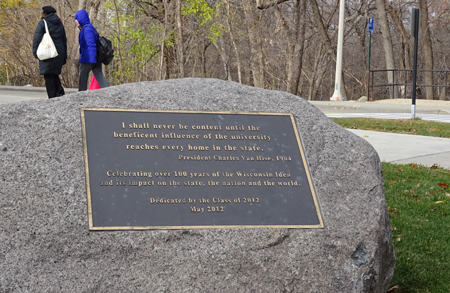
photograph by Libby Robin
The Wisconsin Idea expresses an aspiration that university work can inform and enrich the ‘public good’ including cultural institutions. The University of Wisconsin takes as its brief to benefit all the citizens of Wisconsin, not just those who have the privilege to be its students. As well as repaying the investment of the state in its university, the public good aspiration has come to hold strong appeal for the state’s benefactors and donors. The Chazen Art Museum in the University of Wisconsin at Madison combines an outstanding collection of modern art and a strong teaching program in art history, including curatorial education, research and leadership programs.
The Nelson Institute’s Center for Culture, History, and Environment (CHE) initiative at the university has also used the support of private donors to develop a range of ambitious programs under the banner ‘Environmental futures’. The film festival Tales from Planet Earth, which has since 2007 successfully screened all over Madison and beyond in a range of venues, including Centro Hispano, a community centre serving Madison’s Latino population, has drawn new local audiences to the university’s programs and has helped to increase diversity within the Nelson Institute for Environmental Studies. In November 2014, the CHE team, Gregg Mitman, William Cronon and Rob Nixon, among others, hosted a new venture, a very different sort of public event, The Anthropocene Slam: A Cabinet of Curiosities.
The ‘slam’ is a concept that originated with poetry, performance and a competitive spirit. The first poetry slam in 1984 was a poetry reading in the Get Me High lounge in Chicago. Poets performed their words and audiences voted with acclamation for the winners. The community audience was essential. The slams were noisy, theatrical and democratic – very different from ‘high art’ poetry recitation. The Anthropocene Slam borrowed the performance and entertainment idea, asking contributors to ‘pitch in a public fishbowl setting’ an object that might represent the Anthropocene in a cabinet of curiosities. From a large field of applicants, 25 objects appeared in five sessions, involving a total of 32 presenters (several objects were presented by teams). The sessions (held across three days from 8-10 November 2014) were grouped into intriguing themes:
- nightmares/dreams
- Anthropocene fossils
- tales and projections
- trespass
- resistance/persistence.
The aim was to find objects that might help humanity rethink ‘its relationship to time, place, and the agency of things that shape planetary change’.[13] This innovative scholarly method was designed from the start to be inclusive of scientific, artistic and practical ideas, extending what is usually possible in academic settings. One of its public outcomes was the performance event in Madison.
The slam presentations were complemented by a major public lecture from journalist Elizabeth Kolbert, drawing on her bestselling book, The Sixth Extinction.[14] An audience of more than 500 people from all over Wisconsin came out on a chilly night to hear this fluent and well-known communicator of big ideas explain the thesis that the loss of biodiversity today is on a scale equivalent to the mass extinctions evident in geological strata. The last (fifth) mass extinction ended the era of dinosaurs. The slam created a context for this important lecture.[15]
Another aspect of the slam was the building of a travelling cabinet of curiosities,to exhibit the most popular objects and stories, and to take them to local communities. Like the original Wunderkammer from the 16th and 17th centuries, the cabinet created out of the slam is as much a cabinet of conversations and global connections as one of objects.[16] The purpose of the slam was to discover objects that might travel to a cabinet in another context: the Deutsches Museum in Munich, Germany, the largest science and technology museum in the world. One item from the cabinet even made it to opening night on 4 December 2014 of Willkommen im Anthropozän, the world’s first gallery exhibition of the Anthropocene.[17]
There will be a more formal reception for the cabinet and its objects in July 2015, in an Anthropocene Objects and Environmental Futures workshop, a collaboration between the University of Wisconsin, the Rachel Carson Center at Ludwig Maximilian University of Munich (LMU), the Deutsches Museum and the Royal Institute of Technology (KTH), Stockholm.[18] The cabinet will also be available to travel elsewhere, including to Sweden, where the KTH Environmental Humanities Laboratory hosted an international variation on the Tales from Planet Earth film festival in 2014.[19]
The ‘call for objects’ drafted by Gregg Mitman and Rob Nixon was rather different from a standard conference or workshop ‘call’:
We are in the midst of a great reawakening to questions of time – across the spans of geological, ecological, evolutionary, and human history. It is a reawakening precipitated, not by a nostalgia for the past, but by a sense of urgency about the future. The Anthropocene, coined in 2000 by ecologist Eugene Stoermer and popularized by Nobel Prize-winning atmospheric chemist, Paul Crutzen, is one of the most resonant examples of how the urgency of the future has prompted scientists, artists, humanities scholars and social scientists to engage creatively with the emerging legacy of our geomorphic and biomorphic powers. The advent of this new scientific object – the Anthropocene – is altering how we conceptualize, imagine and inhabit time. The Anthropocene encourages us to re-envisage (in Nigel Clark’s phrase) future and past relations between ‘earthly volatility and bodily vulnerability’. What images and stories can we create that speak with conceptual richness and emotional energy to our rapidly changing visions of future possibility? For in a world deluged with data, arresting stories and images matter immeasurably, playing a critical role in the making of environmental publics and the shaping of environmental policy.
The Anthropocene is just one among many moments in time when new scientific objects have altered humanity’s relationship to the past, present, and future. The coming-into-being of scientific objects such as fossils, radioactivity, genetic mutations, toxic pesticides, and ice cores, to name a few, have precipitated different narratives and imaginings of the human past and the human future. What might a cabinet of curiosities for the age of the Anthropocene look like? What objects might jolt us into reimagining environmental time across diverse scales, from the recent past to deep history? How might certain kinds of objects make visible the differential impacts – past, present, and future – that have come to shape the relationships among human and non-human beings, living in an era of extreme hydrocarbon extraction, extreme weather events, and extreme economic disparity?
… How is the appearance and impact of homo sapiens as a geomorphic force registered in the sediments of history, the objects around us, and the things yet to be? What emotionally layered Anthropocene objects can surprise, disturb, startle or delight us into new ways of thinking and feeling? What objects speak to resilience or adaptation, to vanishing biota or emerging morphologies?[20]
The cabinet also explored ‘future imaginaries’, both ‘utopian and apocalyptic’, considering the ideas of art and science, literature and film, history and policy. This wider Environmental Futures project opened a transnational and interdisciplinary conversation, with a focus on material objects and on the emotional responses (for example, hopes and fears) that they invoked. The challenge for the objects and their presenters was to:
... comprehend and portray environmental change that occurs imperceptibly and over eons of time – and that inflicts slow violence upon future generations – when media, corporate, and political cultures thrive on the short-term.[21]
Cabinets of curiosities
The Wunderkammer started life in German as a ‘room of wonder’, rather than the English ‘curiosity’. The cabinet of curiosities evoked awe. Rather than evoking rational curiosity, a cabinet should enable enchantment, according to political ecologist Jane Bennett:
Thirteenth-century writer Albertus Magnus described wonder as, like fear, ‘shocked surprise’ … but fear cannot dominate if enchantment is to be … it is a state of interactive fascination, not fall to your knees awe.’[22]
‘Awe’ was a word laden with moral and religious overtones in pre-Enlightenment times. In the 21st century, the objects of a cabinet stir questions about the ‘ethical relevance of human affect’.[23]
The rarity of objects in the era of the Wunderkammer added much to their value. In 1500, the average Middle European household had just 30 objects. By 1900, such households contained 400 objects. The proliferation of objects continued throughout the 20th century, rising to 12,000 objects per household in 2010.[24] The sheer number of objects in modern life changes them: they are no longer precious but rather just ‘stuff’, too many to count or care about. An Anthropocene-era cabinet of curiosities rediscovers objects that can stir wonder, curiosity and care, even for a jaded 21st-century viewer, whose home is burdened with an excess of objects. Each object’s story needs to be evocative, remarkable, perhaps even luminous. Even a prosaic object can carry a big story. This can be assisted by a great ‘pitch’ or performance that breathes life into the story.
When objects have lost their stories and their place in the lives of their owners, they are just stuff. When the stories are remembered and embraced with the object, they stimulate memories and reflection. These can even have clinical value for those suffering from memory loss. Keeping the context of the object simple and clear is often better for stimulating memory than cluttering it with high-tech apps.[25]
Restoring enchantment to objects demands retelling their stories, making individual objects special and important to identity again. The slam was a deliberate strategy to foster engagement and to enliven and reinvigorate objects, to sponsor a ‘sense of play’. It was a technique that could ‘hone sensory receptivity to the marvellous specificity of things’ and, above all, that could ‘resist the story of the disenchantment of modernity’, in Jane Bennett’s words.[26] The challenge of the Anthropocene is its scale. It may seem so large and frightening that it makes people feel they can do nothing about it. The performance event is a strategy for keeping open possibilities for adaptive strategies in the face of rapid change, allowing objects to explore facets of a bigger story in smaller, playful ways.
Neil MacGregor’s History of the World in 100 Objects is one attempt to tell human history ‘from out of Africa to the credit card’. He argues for the levelling power of objects: not all societies have text to tell their stories, but objects may survive to speak from cultures beyond the written word. A history created from objects can include the 95 per cent of human history that is only told in stone. [27] While organic objects cannot survive indefinitely, and fragile objects are more likely to be lost than robust ones, the survival of an object is not just physical: it is also testimony to a cultural context where someone cared enough to protect this object – perhaps in a grave, perhaps in a pocket. Small objects may survive better than large. Edmund de Waal’s imaginative memoir The Hare with Amber Eyes, told through his global family’s netsuke collection, shows just how powerful a small and special object can become. Netsuke are tiny Japanese ceramic, wood and ivory carvings (originally merely a functional addendum that enabled men to carry a tobacco pouch on a kimono). The de Waal collection of netsuke moved through generations and over a century of extraordinary international events, holding the family memories across time and space, and encapsulating his family’s history.[28]
If we follow Neil MacGregor’s notion of a museum as a place that enables ‘the study of things [which] can lead to a truer understanding of the world’[29], then we have a particular new challenge to find the poignancy of objects in a time when there are too many of them. Which objects might enchant audiences and museum visitors in a world marked by the proliferation of things? How can we learn to wonder or be curious about ‘stuff’? The answer, in Mitman’s vision, is that we select and perform or present just a few objects, juxtaposed with others that can carry the Anthropocene story in quirky ways. When the idea of global change is too big and abstract for human comprehension, a small cabinet can act as a microcosm to enable an imaginative and active response. Each object is there for its own story. Together in a cabinet they become a chorus of stories.
The object
One of the 25 objects ‘performed’ at the Anthropene Slam and subsequently selected for the Deutsches Museum’s Anthropocene Wunderkammer was a domestic pesticide applicator. The familiar bike-pump-sized pesticide sprayer was a popular household item from the 1920s to the 1950s. In the United States the Standard Oil Company’s ‘Flit’ brand of insecticide became synonymous with the spray pump. Other countries had their own brands: in Australia it was Mortein.
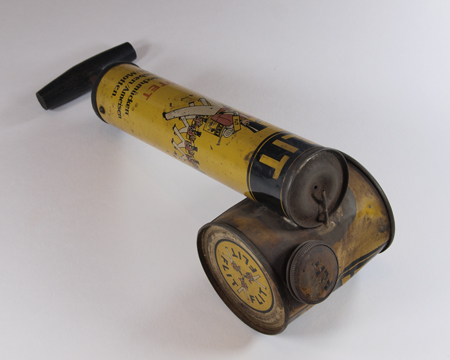
Hamburg Museum
The pesticide pump sprayer speaks of a faith in science to improve lifestyles, and the hubris of humanity’s desire to control nature. The sprayer’s genealogy links to both the Agricultural and Industrial revolutions, each a break in time that has been argued to mark the Anthropocene.[30] It is an object born of the demographic shift towards large urban populations, and the demands for greater intensification and efficiencies in food growing that make that shift possible. Until the mid-20th century (the likely date stratigraphers will use for the dawn of the Anthropocene[31]), most older-generation pesticides had been available for hundreds of years. Soaps, oils, salt, sulphur, and more toxic substances, such as those derived from arsenic, lead and mercury, were applied in all manner of ways. It was the social and economic changes of the 19th century, however, that drove sprayer development, as growers sought to cover plants and trees on a larger scale, with more efficiency.
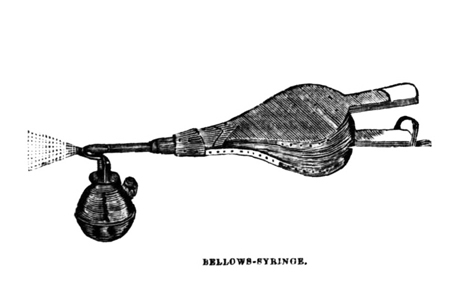
The Sydney Mail and New South Wales Advertiser
As early as the 1870s, American Agriculturalist reported a French horticulturalist using bellows across a nozzle to disperse insecticide. The article explains that the device and its production of ‘liquid dust’ use the same principles of fluid dynamics as a perfume sprinkler or medical atomiser.[32] A fine spray could cover all of a tree more easily, quickly and without wasting pouring liquid or dusting. By the 1890s the use of portable and horsedrawn pesticide sprayers was so common that the New South Wales Minister for Mines and Agriculture held a field competition in December 1890 at Parramatta to determine the best and most efficient commercial insecticide sprayer. The Australian-made ‘Farrington’ machine was fitted on a cart and could spray 500 gallons per day. Some needed two operators but others could be used by a single person, pumping with one hand and holding the sprayer with the other. The Lowe’s machine had a three-in-one action: it could spray, fumigate and expel a hot vapour of sulphur and steam near its nozzle. Observers noted that cross-winds often wasted the fumigant, so some orchardists proposed enveloping trees in tents that could ensure the expensive fumes were trapped where they were needed. On the day, the most impressive sprayer was a new machine from the United States. It was compact and used compressed air rather than a hand pump to create the hydraulic pressure, so ‘all that the orchardist has to do is stand at the nozzle and blaze away at pest and disease’.[33] It was the fastest of the sprayers in the competition, dressing a tree in just two-and-a-half minutes.
At the same time that chemical companies were advertising pesticide formulas to landholders in the late 19th century, they were adapting agricultural sprayers to deliver chemicals for domestic gardens and inside the home.[34] From the 1920s, when better sprayer design and pervasive chemical industry advertising combined with higher household incomes and campaigns for improved domestic hygiene and ‘mothercraft’, the familiar home pump sprayer became widely used. After the Second World War, the sprayer formulas became longer lasting and more effective, with new synthetic chemicals. Less than two decades later, the public began to discover that the miracle chemicals were not as safe as they had been led to believe.
Performing the object
A ten-minute ‘slam’ format presents a challenge to historians in particular, who by their nature and training, are dedicated to providing context. How much story, information and reflection is possible in ten minutes? The format shaped the form and selection of story – the performance had to provoke and begin a conversation. It would not be possible to explain everything. The invited presenters, Michelle Mart and Cameron Muir, opened their performance by playing characters, two archetypes associated with the use of chemicals in different contexts – domestic, urban, wealthy on the one hand, and industrial, rural and poor on the other.[35]

H Armstrong Roberts/ClassicStock/Corbis
Michelle Mart appeared as a 1950s housewife, a stereotype from the period’s advertising posters come to life, complete with lipstick, pearls and twin-set. She advocated the convenience and virtues of a bug-free household, as images projected in the background showed advertising and stylised scenes of the suburban ideal. Successful domestic management, or orderliness, cleanliness, and wholesomeness: perfect weed-free lawns, insect-free kitchens, and unblemished fruit and vegetables. Mart was the woman who stood on the veranda of a neat, architecturally designed house to welcome her husband home from work. Her home was managed with a pump spray that dispersed DDT through the kitchen cupboards, just like in the military, where officers were photographed spraying DDT down a fellow serviceman’s shirt. Some of the men came home from being sprayed in wartime service to the new peacetime spraying on the suburban frontier.
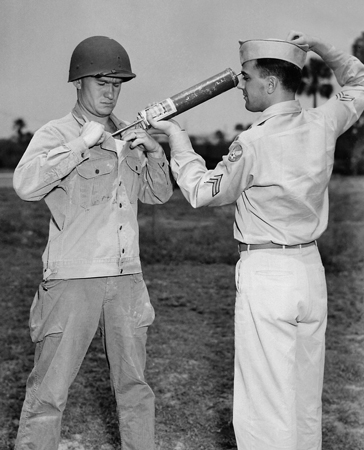
Centres for Disease Control Public Health Image Library
Advertising urged homeowners to use chemicals for the sake of the family’s health (some thought polio was spread by the housefly), while another has fruit and vegetables singing, ‘DDT is good for me-e-e!’ Mart’s 1950s character proclaimed she is ‘lucky to live at a time when the wonders of modern technology and chemistry have transformed our lives’, and best of all, the new chemicals are ‘safe for everybody’.[36]
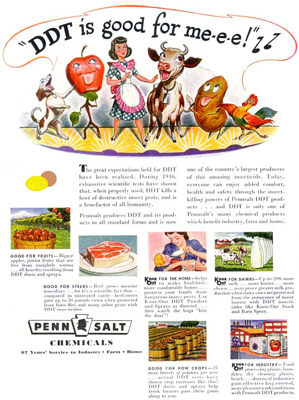
Collector’s Weekly
At this point the second character entered: Cameron Muir was an agricultural worker in a white, full-body chemical hazmat suit, including hood, gloves, goggles and face mask, and carrying a large knapsack pump sprayer adorned with lurid red-and-black warnings about its toxicity. We have moved beyond the innocence of postwar hubris in scientific and industrial expertise, but users are exposed to more chemicals than ever. The agricultural worker character speaks of his brother, who blames the pesticides for illnesses and behavioural problems in his children. He wants to leave the job of spraying but he can’t find work elsewhere. The worker fears local complaints about the chemicals will endanger their relationship with the company employing them.

International Livestock Research Institute
The images projected in the background show the faces of individual agricultural works in developing countries, some of them disfigured by pesticide exposure and light aircraft spraying vast fields. Amidst health concerns and well-informed anxiety about spraying pesticides, industrial agriculture has scaled up again in the 21st century.
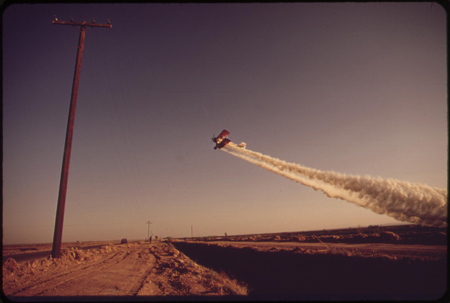
Charles O’Rear/The US National Archives
The object and performance as provocateur
Who owns the story of pesticides? The narrative of triumphant technological progress and control of nature continues to hold influence even in the face of startling costs and unintended consequences. Social and political commentators still attempt to discredit Rachel Carson’s Silent Spring 50 years later, while the chemical and seed industries sell promises of control, simplicity and safety to farmers wracked by the reality of an unpredictable nature and markets. More powerful than earnestness and statistics, Mart and Muir’s performance gave the voice to the Flit spray can and used it to retell the stereotypical narrative of technological progress. Humour, irony and juxtaposition can be more effective than numbers in exposing hubris in the failed narrative. The presentation made its point not just by telling, but by showing. It is a human story. The archetypal characters, images and objects spoke for themselves; each member of the audience actively made their own interpretations and connections.
Towards the end of the presentation, Mart and Muir stepped out of character and spoke to the audience directly, personally. The ‘pitch’ or telling mode was reserved until the object story and its historical frames had been performed beforehand. The background or hypertext for the performance included the bigger scale, Anthropocene stories: since the Second World War humans have released more than 80,000 chemical compounds that no organism had previously encountered in the 3.5-billion-year history of life on earth.[37] This profound change will persist in the geological record and in our genetic legacies. Everyone is still exposed to this chemical soup. Researchers in the Lancet Neurology have declared we are in the midst of a ‘global, silent pandemic of neurodevelopmental toxicity’.[38] It’s even worse for those who farm or who live in the world’s most polluted places. The presentation ended with a provocative set of images. In the 1990s anthropologist Elizabeth Guillette asked children from the Yaqui Valley in Mexico to draw simple pictures – one group was from the agricultural lowlands, the other from the pesticide-free highlands. The children from the agricultural region could barely form shapes.[39] The difference in the drawings was a striking visualisation of what is largely an invisible agent of harm. It was also an illustration of the geographic inequality of toxic burdens.
The chorus
The domestic pesticide applicator object was one of 25 performed in the Madison Chorus. It has now been chosen to travel on to the Deutsches Museum, where a new cabinet of curiosities will be re-assembled in July 2015 with some of the Madison objects and some new, locally chosen Anthropocene objects. Global changes are everywhere, but human responses are personal, local, and the slam was an event for Madison. Munich is another context: another language, a science and technology museum, and the juxtaposition of the cabinet with a whole gallery of ideas and objects for the Anthropocene.[40] What the Madison cabinet brings is an event and a set of objects that can interrogate the gallery project for the Deutsches Museum and its university partner, the Rachel Carson Center. It also invites local content – objects that have resonance in Munich. The slam-style event works to collect together the object stories and to draw out patterns and sympathies between them.
The Anthropocene Slam created a chorus of objects that worked together in Madison, juxtaposed with each other and the performances of their presenters. In fact, the audience was reluctant to vote for ‘best object’ in each section; these were not solo objects or voices, but rather notes that together created chords of global change stories, stories that were layered together with others. It didn’t make sense to pick out the ‘tenor’ or ‘soprano’ line for special attention. The poetry slam is usually a competition with a cash prize. The Anthropocene Slam resisted the competitive framework. Rather, it invited scholarly collaboration in a playful context. The shift from competition to chorus was its great success, enabling collaboration and partnerships and the reflections arising from some very different objects.
The global and the local
The Anthropocene Slam suggested one way to scale the abstract and global through personal objects. It created an object-conversation that worked for all ages and in intergenerational contexts. Educating citizens about living with global change is not a task for schools alone. This story affects every generation. As the Deutsches Museum has already realised, museums can be partners in this global education, and are ideally suited to intergenerational conversations: grandchildren and grandparents already often visit a museum together.
HKW took the scholarly mission to educate people about the Anthropocene as its focus, as part of a two-year Anthropocene Project. For 11 days in November 2014, HKW created an international ‘Anthropocene Campus’, where its galleries showcased the exhibitions, video documentaries and artworks developed through its Anthropocene Project. Campus participants worked to develop a ‘curriculum’, including textbook and online teaching materials, through seminars and workshops on approaches to the ideas of the Anthropocene. Nearly 30 presenters worked with more than 100 interested participants, doctoral and postdoctoral scholars and practising artists.[41] Most of the presenters came from scientific disciplines leading Anthropocene discussions (especially earth, atmospheric and ocean sciences). Participants included a significant number of designers, museum specialists and visual artists, as well as scholars of earth sciences and environmental humanities. The boundaries between science and humanities dissolved in the intense program; the need to communicate and to teach and learn demanded clear, non-technical language and strong images. The overwhelming thrust of the curriculum materials was to develop human and emotional responses to the Anthropocene, as well as ways to converse beyond disciplinary silos to work together to solve problems and engage audiences.
Thinking with museums
How can we slow down the future to enable a sense of control? What is globally curious? What will we ‘wonder’ at in future? What sort of objects should we collect now for museums of the future? These are all urgent present problems as we imagine how museums will work in the changing circumstances of the Anthropocene. For Collecting the Future, a museum event at the American Museum of Natural History in October 2013, Jennifer Newell, Libby Robin and Kirsten Wehner specifically investigated what communities might collect for community museums of the future in local places that are changing fastest. What objects and stories can travel from depopulating Pacific Islands (where people are confronted with salinising ground water and rising seas) to their new communities in New Zealand or New York? These practical questions about living with climate change can bring communities into museums to use their collections in new ways. Community museums, national museums, science museums and art museums are all members of the Museums and Climate Change network of exchange that emerged from this event.[42]
In Australia, as elsewhere, the arts have been engaging with ideas for imaginative futures through local museums and events. Climarte is one such group that ‘harnesses the creative power of the Arts to inform, engage and inspire action on climate change’.[43] It is an arts-led partnership including prominent artists, Nobel-Prize-winning scientist Peter Doherty and directors of key galleries, Maudie Palmer (founding director of Heide Museum of Modern Art and TarraWarra Museum of Art) and Stuart Purves (director of Australian Galleries, Australia’s longest and most established commercial art gallery). Australian Galleries will host the 2015 Climarte Festival’s opening exhibition, The Warming, curated by Mandy Martin, who was one of the international artists attending the Wisconsin Anthropocene Slam. The exhibition brings together eight artists from Australian Galleries with 17 additional artists who have been invited to contribute an ‘Anthropocene cabinet of curiosities’, a plinth of objects at the heart of the show. Some of the artists will also pitch their ‘curious object’ briefly at a special event on 3 May 2015, and there will be responses from moderators, Peter Christoff (from the University of Melbourne and formerly Victorian Commissioner for the Future), William L Fox and Libby Robin. The aim is to create an event to inspire new thinking about what the arts can do in a future beyond the Holocene.
The future is often constructed through the lens of economic expertise. For example, the Australian Treasury has issued a 2015 Intergenerational Report that focuses exclusively on the economic burdens that the present generation places on those living in 2055.[44] Sometimes it is earth system scientists, or climate modellers who describe futures – for example, under the Intergovernmental Panel on Climate Change (IPCC) scenarios of 2 or 4 or 6 degrees of warming. Yet the future is also about cultural and moral choices, not just economics and environment. The worlds of 2055 and beyond will be more than just climate spaces and economies. The museum sector is poised to treat the future as a ‘cultural fact’, in Arjun Appadurai’s terms. Appadurai writes of a future that includes ‘imagination, anticipation and aspiration’.[45] The future is not just about imagining nature or anticipating economic conditions, it is also about aspiration. While ‘probable’ futures are generated by mathematical models of nature and economics, such models often offer little hope. An alternative is to look to museums, to objects and to the creative dialogues of personal visits and performance events to foster qualitative possible futures. The future is not just a technical or neutral space: it is ‘shot through with affect and sensation’.[46] Science and scholarship alone often lack important sensations for imagining the future: ‘awe, vertigo, excitement, disorientation’. Rather than just measuring change in our world – or denying that there is any – we can take a third way that acknowledges change, including, but not only, climate change. Cultural institutions have an important role in enabling communities to get on with living positively with the changes of the Anthropocene. Culture works through ‘the traction of the imagination’, expanding the possibilities for ways to live with the future as it unfolds.[47]
This paper has been independently peer-reviewed.
Endnotes
2 Violent Ends: The Arts of Environmental Anxiety.
3 www.theguardian.com/commentisfree/2014/sep/21/desmond-tutu-climate-change-is-the-global-enemy.
4 Jan Zalasiewicz, Colin N Waters, Mark Williams et al., ‘When did the Anthropocene begin? A mid-twentieth century boundary level is stratigraphically optimal’, Quaternary International, 12 January 2015, http://dx.doi.org/10.1016/j.quaint.2014.11.045.
5 PJ Crutzen, ‘Geology of mankind’, Nature, vol. 415, no. 6867, 2002, 23.
6 Christian Schwägerl, The Anthropocene: The Human Era and How it Shapes the Planet, Synergetic Press, Santa Fe/London, 2014; Luke Keogh & Nina Möllers, ‘Pushing the boundaries: Curating the Anthropocene at the Deutsches Museum’, in Fiona Cameron & Brett Neilson (eds), Climate Change, Museum Futures: The Roles and Agencies of Museums and Science Centers, Routledge, London, 2014, pp. 78–89.
7 Currently chaired by Jan Zalasiewicz, who has worked extensively with humanities scholars (at the University of Chicago and the University of Sydney), and has supervised art projects such as the French artist Yesenia Thibault-Picazo’s Cabinet of Future Geology, currently showing at the Deutsches Museum, Munich, until 2016. In 2015 another version of Thibault-Picazo’s work will be part of the Globale Festival in the New Media Museum, Karlsruhe, Germany.
8 Bernd Scherer (ed.), The Anthropocene Project: A Report, HKW, Berlin, 2014; Libby Robin, Dag Avango, Luke Keogh, Nina Möllers, Bernd Scherer & Helmuth Trischler, ‘Three galleries of the Anthropocene’, Anthropocene Review, vol. 1, no. 3, 207–24.
9 W Steffen, J Grinevald, P Crutzen & J McNeill, ‘The Anthropocene: Conceptual and historical perspectives’, Philosophical Transactions of the Royal Society A,vol. 369, 2011, 842–67.
10 Mike Hulme, ‘Reducing the future to climate: A story of climate determinism and reductionism’, Osiris, vol. 26, 2011, 245–66, p. 245.
11 Jan Zalasiewicz, ‘Buried treasure’, in Geoff Manaugh (ed.), Landscape Futures: Instruments, Devices and Architectural Inventions, Nevada Museum of Art and Actar, Reno, 2013, pp. 258–61.
12 Susan L Dautel, ‘Transoceanic trash: International and United States strategies for the Great Pacific Garbage Patch’, Golden Gate University Environmental Law Journal, vol. 3, no. 1, 2009, 181–208. This sort of global phenomenon (which grew and changed shape dramatically after the tsunami that struck Japan in 2011) has been very effectively illustrated in museums through ‘Science on a Sphere’ technology created by National Oceanic and Atmospheric Administration (NOAA) Alaska State Museum, Juneau, http://juneauempire.com/stories/050109/ent_435381904.shtml#.VRTsEfmUeCc.
13 From the ‘Call for objects’ (distributed through H-Net online 2013), www.carsoncenter.uni-muenchen.de/download/events/cfps/cfp_cabinet-of-curiosities.pdf.
14 Elizabeth Kolbert, The Sixth Extinction: An Unnatural History, Henry Holt and Company, New York, 2014.
15 Crutzen, ‘Geology of mankind’ (p. 23).
16 Oliver Impey & Arthur MacGregor (eds) The Origins of Museums: The Cabinet of Curiosities in Sixteenth and Seventeenth Century Europe, Clarendon Press, Oxford, 1985.
17 Welcome to the Anthropocene: The Earth in Our Hands (in English). The exhibition gallery opened 4 December 2014, and will run till 2016; Nina Möllers, Christian Schwägerl & Helmuth Trischler (eds) Willkommen im Anthropozän: Unsere Verantwortung für die Zukunft der Erde, Deutsches Museum, Munich, 2014; see also Libby Robin, Dag Avango, Luke Keogh, Nina Möllers, Bernd Scherer & Helmuth Trischler, ‘Three galleries of the Anthropocene’, Anthropocene Review, vol. 1, no. 3, 2014, 207–24, doi:10.1177/2053019614550533.
18 Munich, 5–7 July 2015, www.carsoncenter.uni-muenchen.de/events_conf_seminars/calendar/ws_anthropocene-objects/index.html.
19 www.kth.se/en/abe/inst/philhist/historia/2.45962/2.60531/tales.
20 nelson.wisc.edu/che/anthroslam/about/index.php.
21 From Environmental Futures unpublished prospectus (‘Call for papers’), 2013; see also Rob Nixon, Slow Violence and the Environmentalism of the Poor, Harvard University Press, Cambridge, Mass., 2011.
22 Jane Bennett, The Enchantment of Modern Life: Attachments, Crossings, and Ethics, Princeton University Press, New Jersey, 2001, p. 5, emphasis added.
23 Jane Bennett, Vibrant Matter: A Political Ecology of Things, Duke UP, Durham, 2010, p. xi.
24 Christof Mauch, ‘The Great Acceleration of Objects’, Plenary panel, Anthropocene Slam, UW Madison, 10 November 2014.
25 Charles Leadbeater, ‘The disremembered’, Aeon Magazine, March 2015, http://aeon.co/magazine/psychology/where-does-identity-go-once-memory-falters-in-dementia.
26 Bennett, Enchantment,p. 4.
27 Neil MacGregor, A History of the World in 100 Objects, Penguin, London, 2012 (1st edn 2010), p. xix.
28 Edmund de Waal, The Hare with Amber Eyes: A Hidden Inheritance, Vintage, London, 2011.
29 MacGregor, History of the World, p. xxv.
30 William F Ruddiman, ‘The Anthropogenic Greenhouse Era began thousands of years ago’, Climatic Change, vol. 61, no. 3, 2003; Crutzen, ‘Geology of mankind’.
31 Zalasiewicz, Waters, Williams et al., ‘When did the Anthropocene begin?’.
32 ‘Destroying insects – Bellows-Syringe’, Sydney Mail and New South Wales Advertiser, 28 March 1874.
33 ‘Death to fruit pests and diseases: Experiments with appliances’, Cumberland Argus and Fruitgrowers Advocate (Parramatta, NSW), 13 December 1890.
34 Will Allen, The War on Bugs, Chelsea Green, White River Junction, Vt, 2008.
35 Michelle Mart (Pennsylvania State University) and Cameron Muir (Australian National University), both former fellows of the Rachel Carson Center, Munich, independently suggested the sprayer. They were both among the group selected to present at the slam, and since they had the same object, they were asked to work together on it.
36 Michelle Mart & Cameron Muir, ‘Flit sprayer’, Anthropocene Slam presentation, 8 November 2014, University of Wisconsin, Madison, USA.
37 Mariann Lloyd-Smith & Bro Sheffield-Brotherton, ‘Children’s environmental health: Intergenerational equity in action – a civil society perspective’, Annals of the New York Academy of Sciences, vol. 11, no. 1140, 2008, 190–200.
38 Philippe Grandjean & Philip J Landrigan, ‘Neurobehavioural effects of developmental toxicity’, Lancet Neurology, vol. 13, no. 3, 2014, 330–8.
39 Elizabeth A Guillette, Maria Mercedes Meza, Maria Guadalupe Aquilar, Alma Delia Soto & Idalia Enedina Garcia, ‘An anthropological approach to the evaluation of preschool children exposed to pesticides in Mexico’, Environmental Health Perspectives, vol. 106, 1998, 347–53.
40 Robin et al., ‘Three galleries’.
41 Scherer et al., The Anthropocene Project; see also Robin et al., ‘Three galleries’, esp. p. 215, doi:10.1177/2053019614550533.
42 Museums and Climate Change Network, www.amnh.org/our-research/anthropology/projects/museums-and-climate-change-network; Collecting the Future event, www.amnh.org/our-research/anthropology/news-events/collecting-the-future; Jennifer Newell, Libby Robin & Kirsten Wehner (eds), Curating the Future,University of Hawaii Press, Hawaii, forthcoming.
43 http://climarte.org/category/climarte-archive.
44 www.treasury.gov.au/PublicationsAndMedia/Publications/2015/2015-Intergenerational-Report.
45 Arjun Appadurai, The Future as a Cultural Fact: Essays on the Global Condition, Verso, London, 2013, p. 286.
46 ibid.
47 ibid.
